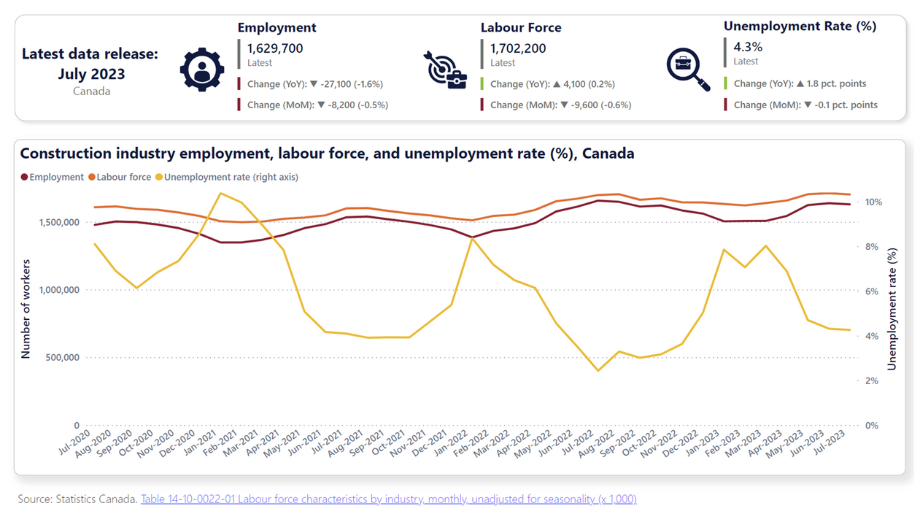July data from Statistics Canada’s Labour Force Survey (LFS) finds all-industry, seasonally adjusted employment levels virtually unchanged from the month previous.
Employment contracted by 6,000 workers for the month as the number of people working full-time and part-time held steady.
As a result of these changes, the national, all-industry unemployment rate rose by 0.1 percentage points to 5.5% in July, following increases in May (+0.2 percentage points) and June (+0.2 percentage points). This trend marked the first time the unemployment rate had increased for three consecutive months since the early months of the COVID-19 pandemic.
Compared with July 2022, seasonally adjusted employment has increased by 435,000. The national, all-industry unemployment rate is now 0.6 percentage points above the level reported 12 months previous.
Key construction indicators hold
Meanwhile, unadjusted data suggest construction continues to make progress in resolving its labour-force challenges.

National industry employment contracted marginally by 26,900 workers (-1.6%) between July 2022 and July 2023, while the labour force recorded a modest gain of 4,300 workers (+0.3%) over the same period. Those factors combined to raise the industry’s unemployment rate from 2.4% in July 2022 to its current level of 4.3%.
This rise in unemployment is not a reflection of a looming crisis. It is more of reflection of a return to more balanced labour markets and potentially a departure from the labour market tightness that has characterized the industry over the past 12 months.
The overall goods-producing sector of the economy, of which construction is a subset, reported an increase in employment of 43,100 (1%) and its labour force (74,800; 1.7%), across the same 12-month period. The sector’s unemployment increased as a result – by 0.7 percentage points, to 3.4% – over the same period.
In terms of positive news, construction also seems to be drawing on women to help close its employment gaps. The number of women employed in the sector grew by 7.3% over the past 12 months, from 209,500 to 224,700. Although this figure is still well below most other industries, it is a positive step forward and a reflection of the heightened industry efforts to increase the number of women in the sector’s labour force. As a share of total employment, women now make up 14% of the total construction sector, compared to just 13% a year ago.
Across the provinces, employment and labour force gains were polarized. Employment gains ranged from highs of 7,500 (+13.8%) in Manitoba and 4,700 (+1.8%) in Alberta to lows of -23,900 (-9.8%) in British Columbia and -7,800 (-16.6%) in Nova Scotia.
The declines in British Columbia, although significant, are expected to be short lived and likely a reflection of several major projects in the province approaching completion. Similarly, the decline in Nova Scotia should also be viewed more as a pause, rather than a decline in demand as the volume of projects in the province slated for construction to commence remains well elevated.
Labour force trends followed a similar pattern, with British Columbia reporting a loss of 17,600 (-7%) and Nova Scotia a loss of 7,500 (-15.4%). Alberta and Ontario reported gains of 13,200 (+1.8%) and 10,200 (+1.6%) respectively, which for Ontario comes as welcome relief to the region which has been struggling for the past 12 months to keep pace with construction demands.
Of note, Prince Edward Island was the only province to report a contraction in its industry unemployment rate over the past 12 months. It reported a drop of 0.1 percentage points, while all other provinces either reported no change or increases of up to 3.4 percentage points.
In terms of the construction labour force, while it declined slightly from June, it remains at a near historic high. In July, the national construction labour force was 1.702 million workers or roughly 7.9% of Canada’s total labour force.


Construction Key Indicators
